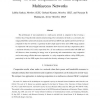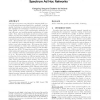5 search results - page 1 / 1 » Bursty relay networks in low-SNR regimes |
TCOM
2010
13 years 2 months ago
2010
—In a wireless network, the use of cooperation among nodes can significantly improve capacity and robustness to fading. Node cooperation can take many forms, including relaying ...
CORR
2006
Springer
13 years 4 months ago
2006
Springer
In this paper we look at the outage capacity of the fading relay channel with half-duplex constraint in the low SNR regime. First we consider the scenario that the channel state i...
CORR
2008
Springer
13 years 4 months ago
2008
Springer
The performance of user-cooperation in a multi-access network is compared to that of using a wireless relay. Using the total transmit and processing power consumed at all nodes as...
CORR
2007
Springer
13 years 4 months ago
2007
Springer
— We consider a dense fading multi-user network with multiple active multi-antenna source-destination pair terminals communicating simultaneously through a large common set of K ...
MOBIHOC
2005
ACM
14 years 4 months ago
2005
ACM
This paper proposes a new principle for designing MAC protocols for spread spectrum based ad hoc networks ? inducing spatial clustering in contending transmitters/receivers. We fi...


